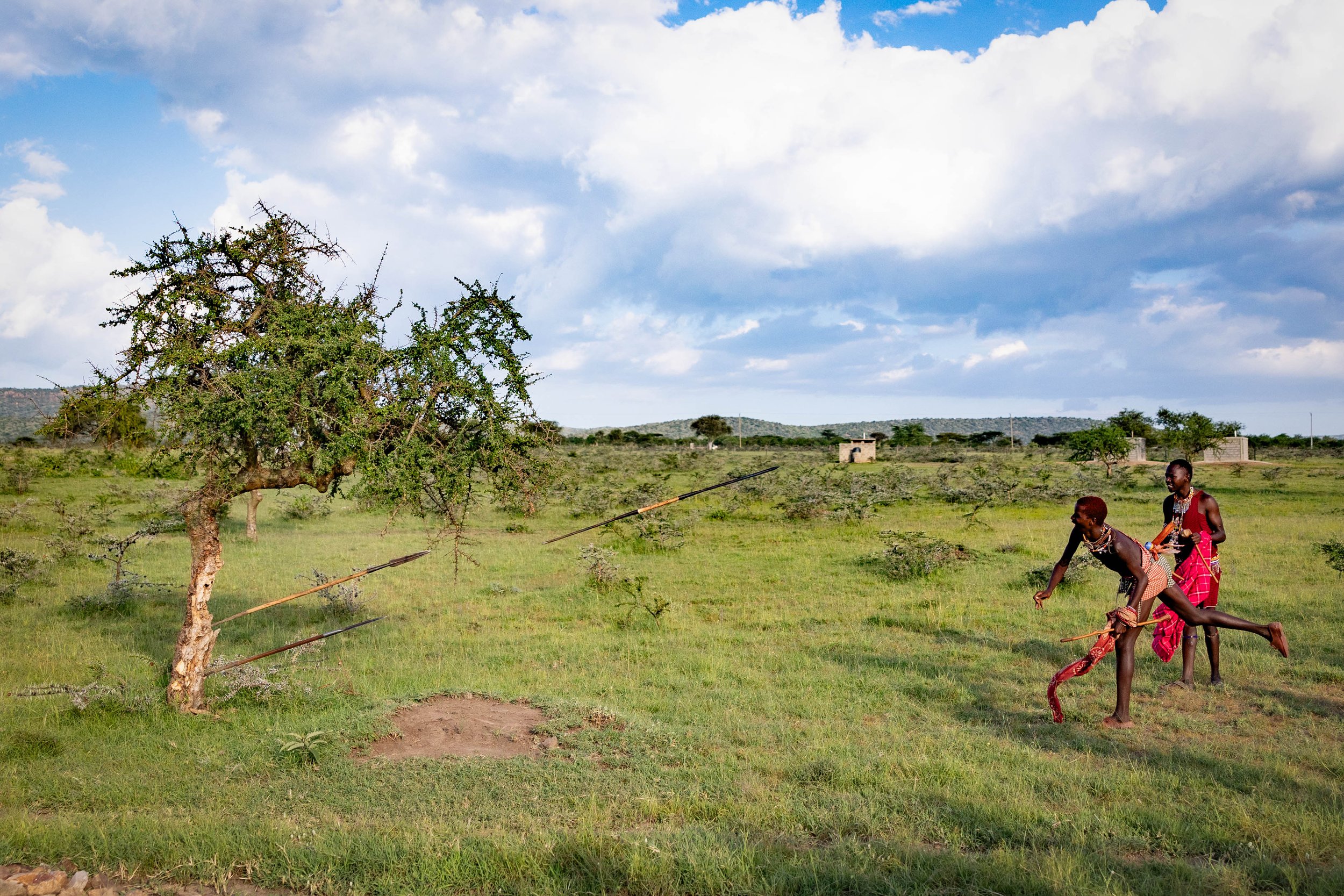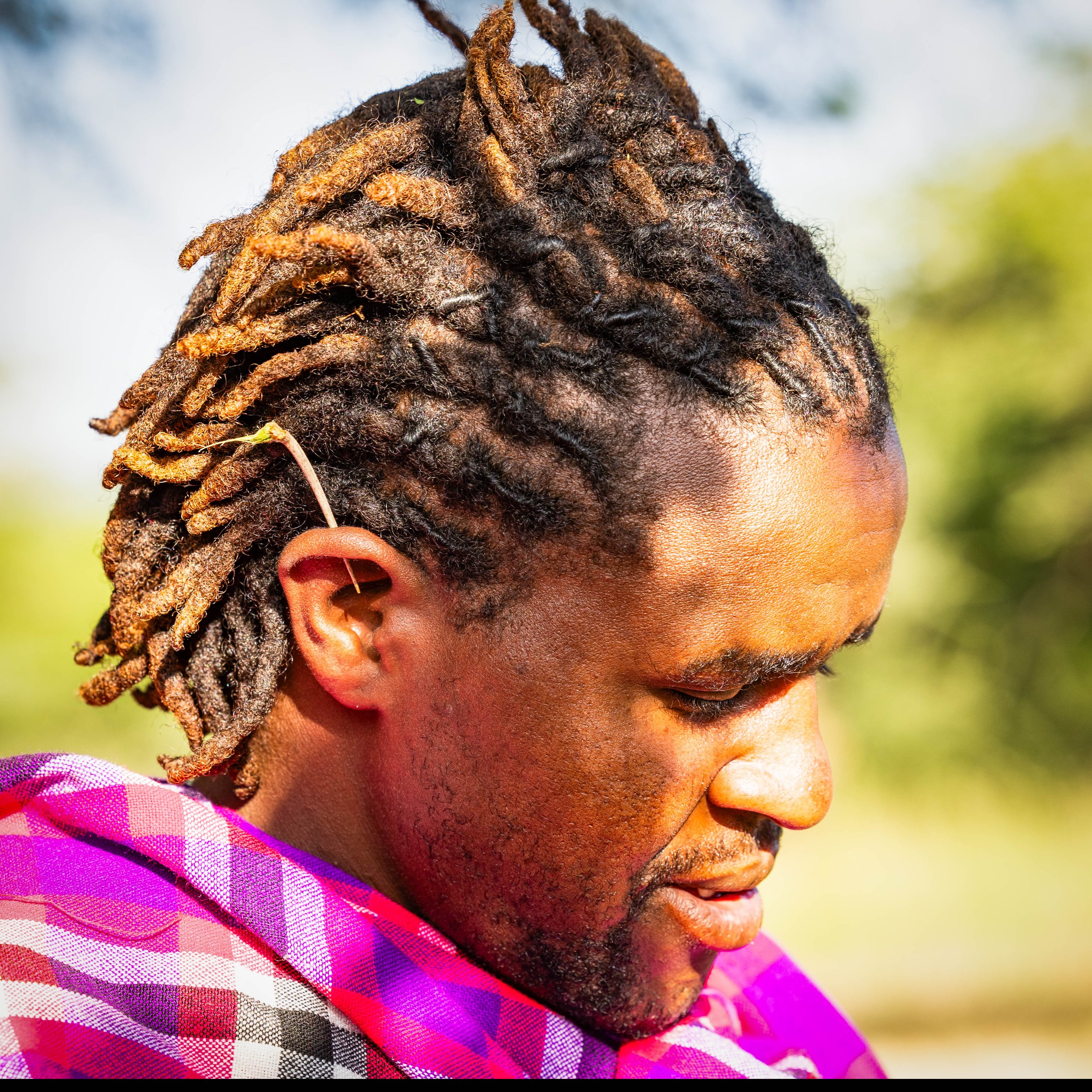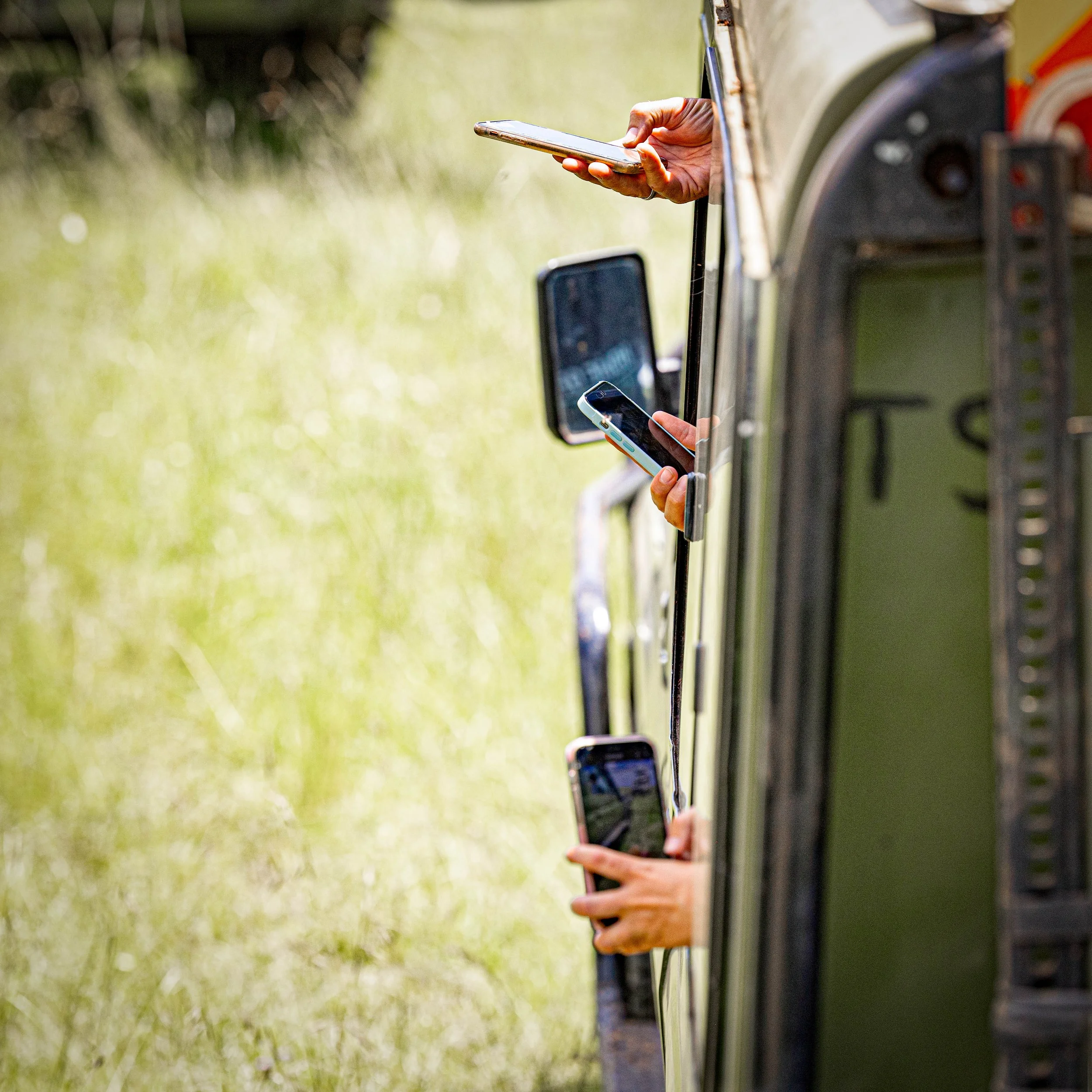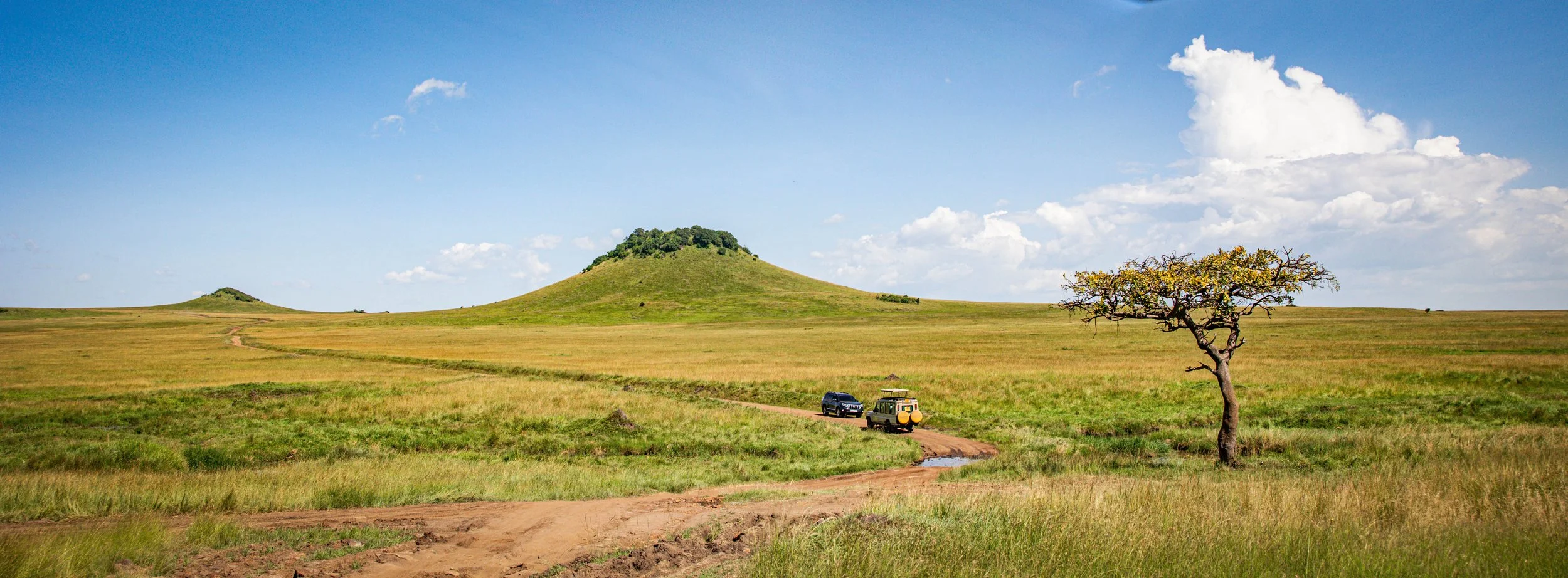Massai Mara
Hellen is a local hero, a teacher, a campaigner for Massai women’s rights. Hellen was sold for three cows and a goat to a 70 year old man when she was only 12. She was to be his fifth wife and he died shortly after the wedding. In Massai culture a woman can only marry once, for a Massai widow, life can be very hard.
We stay at Hellen`s campsite near to the traditional Massai village where she provides shelter and an income for Massai widows. Helen trained as a teacher and works within a local school, she works hard to ensure that the girls are allowed to complete their schooling by bartering with the Massai herders for access to the water from her well. The Massai men collect us from the campsite and bring us to the village. The sing a traditional song to let the women inside know they have returned and the women respond with a song to invite them past the village wall, greeting each other with a clap like two football teams. The children greet us by offering their head to place a hand on top and we say ‘Sopa’ to them.
Hellen has grown a living wall of trees around the village to protect the lifestock and villagers against leopards. The living wall is a sustainable solution instead of cutting down spiky branches to form the wall. Solar panels inside provide lighting to the small mud walled houses where the families live. Livestock are guarded at night in an inner pen. The Massai women sit making handcrafted items for tourists and use foot pedal powered sewing machines to produce garments and bags. “The Mzungu aren’t stupid” Hellen tells us, “they won’t pay twice as much for one item on one table than on another” and has got the women to set a common pricing structure across the items they produce. Hellen and her seamstresses use the money they earn to produce free toiletries for young girls and women. This allows the girls to attend school during their day and generally gives the women more freedom of movement.





























As night falls back at the camp, the Massai men light a fire then leave us alone with a few of the women from the village. Hellen tells us about her experiences and the culture of the Massai. There are nine Massai clans, marriages are arranged between the clans and a dowry in the form of cattle is paid to the parents of the girl. If the man dies and the family want the child back they have to return the dowry to the other family. Massai count wealth through their livestock and obtain most of their nutrition from their animals in the form of milk, meat and blood.
One clan wanted to mark their girls so they would be able to keep track of them, deciding on female circumcision to do so, this then became common practice within the Massai. The health problems relating to FGM can be severe, the practice is outlawed in Kenya and Hellen works to protect young girls.
Within a Massai community children are brought up together, living with their own and other families. For the the first two years a child will stay with their mother before living with the rest of the community. After the first two years the child will have a ceremony and the hair shaved and the mother is allowed to fall pregnant again. Massai are grouped within age sets, with specific ceremonies for when boys become young warriors or graduate to senior warriors. Becoming a senior warrior used to be accomplished by hunting a lion with a spear, but is now through other challenges set to prove manhood.
The next day Hellen takes us around the plants they have and their uses within Massai culture, the massai men demonstrating how to use a white rock to draw patterns for hunting camouflage. She cuts a piece of aloe vera which is used for mosquito bites and wounds. A toothbrush is made from from sticks of a tree, sharpened at one end and also keeps the teeth white and healthy. A thorn from a yellow acacia tree can be used for sewing or piercing ears, and we’re a little surprised when one warrior deftly pieces the ear of another.

















The lion cub calls hungrily to its mother, “it’s difficult for the lions around this time of year” the guide tells us, “many of the cubs have died.” There are still plenty of animals here in the long grass of the Massai Mara but most of the prey animals have migrated south to the Serengeti. Lions are visual hunters and struggle with hunting the animals in the long grass. The lions look for shade in the hot afternoon sun and find that our safari Land Rover is a good place to lie under. A big male pads over and lies down between the two other land cruisers, snarls as a tourist puts his head out to take a photo who then finally heeds the drivers warning and quickly winds the window up.
Leaving the national park, we too quickly wind the windows up. Massai women selling tourist trinkets await by the gate. They are the most persistent of all sellers of tat, shoving beads and carved animals through the window and they certainty don’t take no for an answer.



























We return the next morning to the Massai Mara National Park and head back to visit the pride of lions. We pass a group of hyenas on the road but we don’t stop, the lions have made a kill overnight. As the big male pulls at the remains of the buffalo carcass we see the cub tucking in to part of the buffalo. We all give a cheer of delight, the cub will survive! Nevermind the buffalo the male is busy dragging into the bushes.
Further away there is a report of cheetahs from other drivers and our driver speeds off with the Land Rover arriving at a tree surrounded by other safari vehicles. After earlier skillfully driving through muddy troughs without getting stuck like the others, he this time ends up in with the front and rear wheels in two ditches. As the other visitors try to spot the cheetahs in the grass he loudly tries to free the car, wheels spinning as he drives forwards and backwards to escape out the ditches. It’s stuck completely and it may be unwise here to exit the car here to use a tow rope. He beckons to one of the other drivers in our group who reverses against our Land Rover, spare tyres against spare tyres to push the stricken car free. I look back out of the rear window to see the Land Cruiser reversing back for a third attempt and this time much faster than I was expecting. With a loud smash our car is freed from the ditches and we can drive around to a viewing point to see the Cheetahs.































The cheetahs we see are the two remaining brothers of what were known as the Tano Bora, a famous group of five male cheetahs in the Massai Mara. The guide explains that one was killed by a Massai warrior protecting his cattle. They seem quite unperturbed by the commotion our 4x4 caused. They roll over and yawn in the long grass.
It’s our last night together as a group and as darkness falls over the camp, hyenas can be heard whooping loudly. I chat to the guy stoking the fire for the showers to ask them if the hyenas ever enter the camp. He says no and there is an electric fence around the campsite. The guides will always say no there’s never been a problem with the animals. They then tell of the time they woke up with a lion cuddled up on the other side of the tent, or under a drunken elephant reaching for Marula fruit, or the time they had to wait for the lions to finish eating a kill in the middle of the campsite before anyone could leave their tent, or when a big baboon got stuck inside the truck and knocked itself out trying to flee through the windshield.
























Our last night camping is without incident and we travel back to Nairobi. A lot of us have flights the next day and Lufthansa are on strike again. I spend the night fruitlessly trying to rebook via the useless online bot before I finally get a telephone number to rearrange our flights. We spend some of the EU mandated refund for delayed flights on a last minute business class upgrade with the replacement Air Kenya leg to Paris, sleeping in comfort amongst the well heeled travellers. After nearly three months of camping and budget travel this little bit of luxury is well deserved. I have a chat with the flight attendant so Martina can take her camera to the cockpit.
Two more short flights and we are back in Zurich, one bag didn’t make the flight from Amsterdam, but that caught us up a day later.
When I get asked, what was my favourite moment or favourite place, I can’t really answer. We have done and seen a lot. From Namibian desert dune landscapes, gorillas in the jungle, walking up to rhinos in Zimbabwe, to the people on the beach in Malawi, and of course sharing our experiences with our fellow travellers and guides. Back home Martina reflects on her three month travel through Africa. She says she is grateful for having the opportunities to travel, that we are able to save for a long trip, live with an environment with a stable government and a good standard of health care. She would encourage anyone to travel to experience what the world offers.
Martina is planning to exhibit a selection of her photos from our trip at the Make Art not War exhibition at Foto Bastai in Zürich alongside other photographers on the 23rd May to the 2nd June. She will publish news here and her Social Media accounts about this exhibition and future planned events. Leon is interested in publishing a zine - a small book for sale with a selection of her amazing work if anyone would be interested.
Thanks for following along, we hope you enjoyed the photos and stories.
Leon and Martina


